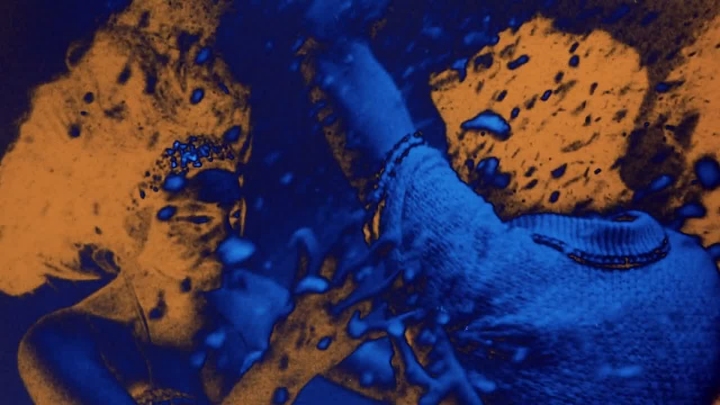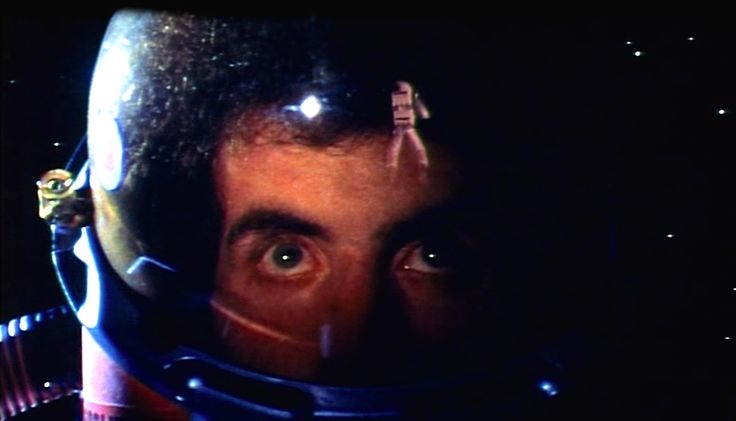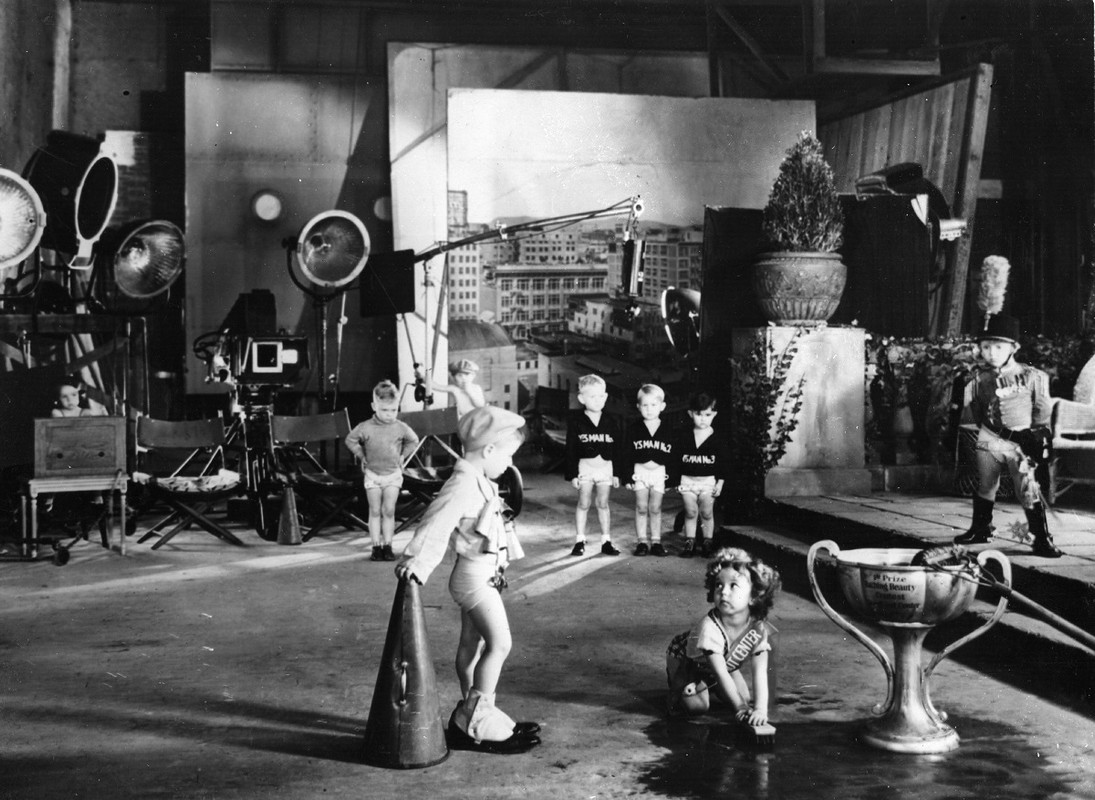“So will someone tell me what happened or not? A brother shouldn't turn against his brother. And a guest shouldn't turn against a guest.”O slavnosti a hostech [A Report on the Party and Guests] (Jan Němec, 1966)
Nov
22
Bales' Birthday

The birthday party mingled in with the others in the woods, all dressed immaculately and seated at elaborately decked tables. The guests and their host raise their glasses towards the camera. DP: Jaromír Šofr.
A birthday party for OP Bales’ birthday!
– the host
satire
儀式 [Gishiki / The Ceremony] (Nagisa Ōshima, 1971)
Nov
11
World Origami Day

A man kneeled in front of a Shintō altar. Ceremonial origami, known as origata or girei origami can be seen hanging from the altar. This is 幣帛 [heihaku], an offering made of cloth or paper. DP: Tōichirō Narushima.
“Speed is the ultimate, all-time high. That first rush. Wow! Just that burning, searing, soaring sense of perfection.” Ciao Manhattan (John Palmer + David Weisman, 1972)
Aug
31
International Overdose Awareness Day

A hollow-eyed Susan Superstar (or Edie Sedgwick, it doesn't matter) getting ready in the morning in one of the 1960s scenes. The cameraman is visible in the many bathroom mirrors. DPs: John Palmer & Kjell Rostad.
28 is no age to die, regardless if your name is Susan Superstar or Edie Sedgwick. But it happened, right during the wrap-up of Ciao Manhattan. Edie was gone, just like that, snuffed like so many of the other #Warhol Superstars. What did remain was footage, so much abandoned footage shot in the 60s when those stars were shining at their brightest. That footage, set in glitzy black-and-white Manhattan, is where Edie and Paul America race around town on amphetamine. Or see a doctor to get shots of some sorts.
– Susan
And there's colour footage too. Susan, topless, semi-(un)consciously dragged around the floor of her empty pool-turned-Superstar-temple. She babbles, drinks, dances around in her panties. And she ODs. Like Edie would even before this movie had seen the light of day.
They snuff so fast, these bright Superstars.
“Do you want to work? What a nightmarish idea” Οι Τεμπέληδες της Εύφορης Κοιλάδας [Oi tembelides tis eforis koiladas / The Idlers of the Fertile Valley] (Nikos Panayotopoulos, 1978)
Aug
21
freebie: World Sleep Day

The maid, father, and two of the sons in a drab, dark green corridor. The men wear burgundy red dressing gowns over their pyjamas and lethargically lean instead of actively sit or stand. The maid wears practical everyday wear and has something to discuss. DP: Andreas Bellis.
Slow cinema of a different kind. We spend long hours in the company of a father (Vasilis Diamantopoulos) and his sons Sakis (George Dialegmenos), Nikos (Dimitris Poulikakos), and Giannis (Nikitas Tsakiroglou). The four of them – rich, bourgeois – have inherited a country villa and the plan is to do nothing for the next seven years. No work, no unnecessary movements. There's #sleep, lots of it. And copious amounts of food prepared by maid Sofia (Olga Karlatos) – she comes with the house; chattels personal – in addition of her body to be consumed by the increasingly idle men.
Οι Τεμπέληδες της Εύφορης Κοιλάδας is a slow satire, quietly addressing Greek #class struggle through the viewer's observation. Who do we follow? The father, who quickly surrenders to sloth; the sons – young, with their whole lives ahead of them; the maid – never questioning her position and slavishly fulfilling her duties of the flesh, in bed and in the kitchen?
The similarities are there but unlike Marco Ferreri's La grande bouffe (1973), there's no culmination in decadence. No euphoria to speak of. No grand release either; while the camera roams the mansion, attuned to #Mahler's tone poem Symphony No. 1 [Titan] – our only clue of the passing of time; even the vegetation succumbs to ennui – the story plods on. One of the men gets dressed, to go to work. It's foolish.
Dillinger è morto (1969)
Glauco (Michel Piccoli) finishing his copious dinner with half a watermelon. In his right hand the copy of the July 25, 1934 Chicago Daily Tribune with the headline CLEAR UP DILLINGER MYSTERY. DP: Mario Vulpiani.

July 31: watermelon on #NationalWatermelonDay
Dillinger è morto [Dillinger Is Dead] (Marco Ferreri, 1969)
Pow!
Industrial designer Glauco (Michel Piccoli) arrives home after a long long, tedious day. His wife Ginette (Anita Pallenberg) – in bed high on painkillers – cooked dinner but the dish is bland and long cold, and the maid (Annie Girardot) is already sleeping. Glauco decides to cook himself a gourmet meal. Looking for ingredients he finds a 1934 newspaper reporting the dead of Chicago gangster John Dillinger with inside of it a rusty 1930s revolver. Fascinated, he meticulously restores the handgun while preparing his meal.
Dillinger è morto is a story of food and alienation. Piccoli's Glauco, bored of his successful career, bored of his beautiful wife, bored of his beautiful house, finds sudden vigour in the act of preparing food and restoring an item that shouldn't be where it is and with that, essentially recreates John Dillinger's escape from Crown Point.
John Dillinger posing with a Tommy gun and the hand-carved wooden gun that he used to escape inescapable Crown Point jail on March 3, 1934. Crudely carved into the dupe's barrel are the words COLT 38.
#Bales2023FilmChallenge #MarcoFerreri #MichelPiccoli #AnitaPallenberg #AnnieGirardot #TeoUsuelli #MarioVulpiani #Italy #drama #crime #satire #food #1960s ★★★★☆
“Clicks, clacks, riding the backs of giraffes for laughs,
S'alright for a while,
The ego sings of castles and kings,
And things that go with a life of style,
Wanting to feel, to know what is real,
Living is a, is a lie”Head (Bob Rafelson, 1968)
Jul
10
Bahamas Independence Day

After Micky (Micky Dolenz, R) jumps of a bridge, the picture becomes pseudo-solarized and to the sweet tunes of Gerry Goffin and Carole King's Porpoise Song, he meets a siren (actress unknown, L). DP: Michel Hugo.
– The Monkees, Porpoise Song (1968)
“Today over lunch I tried to improve morale and build a sense of camaraderie among the men by holding a humorous, round-robin discussion of the early days of the mission. My overtures were brutally rejected. These men do not want a happy ship. They are deeply sick and try to compensate by making me feel miserable.”Dark Star (John Carpenter, 1974)
Jun
23
space lunch

The men enjoying a joyless lunch, consisting of something semi-liquid in a squeeze packet. DP: Douglas Knapp.
– Sgt. Pinback's video diary
“You know, I wish I had my board with me… even if I could just wax it once in a while.” Dark Star (John Carpenter, 1974)
Jun
17
International Surfing Day

Lt. Doolittle (Brian Narelle) dreaming of catching that wave. DP: Douglas Knapp.
On the other end of outer space, far far away from existentialist odysseys and crypto-fascist space operas, there's a little stoner cosmos where a small, dilapidated starship manned by long-haired freaks drifts about.
– Lt. Doolittle
Dark Star started out as a highly ambitious, underfunded student film that, in a blessed pre-Lucas, pre-blockbuster universe, got recognised for its #counterculture glory. In the early 70s, when #surfing was not yet mainstream and a handful of restless pioneers continued west despite the lack of mainland, a cross-pollination between beach blond daredevils and stoner culture happened.
Carpenter's laidback space odyssey fully embraces the beach bum spirit; it's meandering, incoherent, and whatever the superlative of no-budget may be. With at its core: #boredom, the most honest form of cinema.
Könnyű testi sértés [Tight Quarters] (György Szomjas, 1983)
Jun
15
freebie: Flatmates Day

In a claustrophobically framed shot, two men and a woman – Csaba (Károly Eperjes), Miklós (Péter Andorai) and Éva (Mariann Erdőss) respectively – share a small kitchen. DP: Ferenc Grunwalsky.
“This isn’t playtime, kids, it’s work.” “Any star can be devoured by human adoration, sparkle by sparkle.”Kid 'N' Hollywood [Kid in Hollywood] (Charles Lamont, 1933)
Jun
12
Child Labor Day

A movie set on a movie set in Kid 'N' Hollywood. Shirley Temple can be seen on her knees scrubbing the floor as the character Morelegs Sweettrick. Standing next to her with a bullhorn and adult spats is Arthur J. Maskery as the tyrannical movie director Frightwig von Stumblebum. As in all the Baby Burlesk shorts, the kids are only half-dressed with their diapers showing.
Despite Shirley Temple's clear statements of what was going on on set during her child actress days, her output remains wildly popular. Who cannot resist her precocious lines, her cute dimples and baby doll innocence? And tapdancing with ánd befriending a Negro, during the segregation years? Miss Shirley truly was wise beyond her tender age.
Shirley Temple was “discovered” at the age of three by then-casting director Charles Lamont and promptly shot to stardom is his satirical Baby Burlesks: short talkies starring toddlers in diapers (a burlesque being a short, humorous skit). The gag was that the kids behaved and spoke like adults, seemingly unaware of being #children.
– Charles Lamont, Baby Burlesk director
In the Baby Burlesk Kid 'N' Hollywood, Temple plays a Hollywood hopeful called Morelegs Sweettrick, who gets her break when the star doesn't feel like showing up (kids, right? no discipline).
While Kid 'N' Hollywood is relatively innocent, others in the series are much more sexualised (War Babies (1932) stars Temple as prostitute Charmaine) or plain racist (Kid 'in' Africa (1933) with Temple as Madame Cradlebait, bringing civilisation to Black kids portraying fearsome cannibals).
I'm not the one to take events from the past out of context and apply modern-day sensibilities to them, and with the advent of #ChildLabor laws for #Hollywood child actors, many of the horrors recalled by Temple and her peers are history. School is mandatory, long hours restricted, and using twins to split the workload is definitely not unheard of.
And then I watched teevee, and saw chubby, precocious blondes with dental plates to hide their missing baby teeth, wearing lipstick and baby-dolls, grinding and crooning with no backup in sight. And I remember Miss Temple say:
– Shirley Temple
